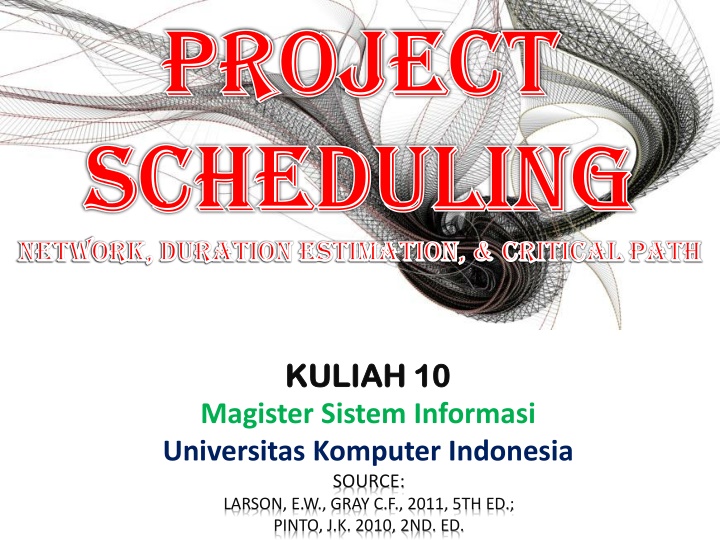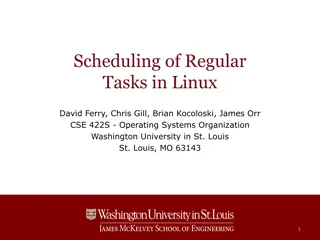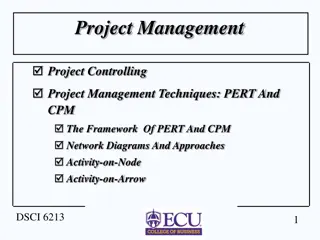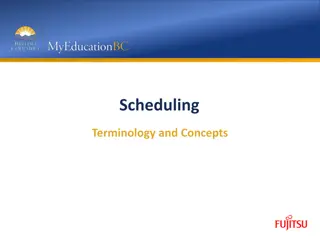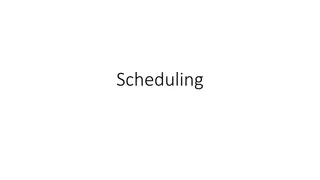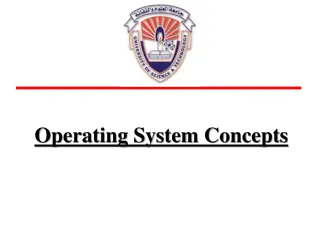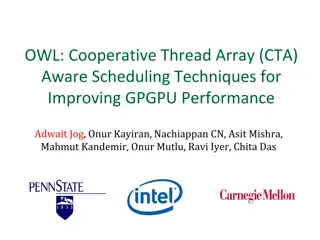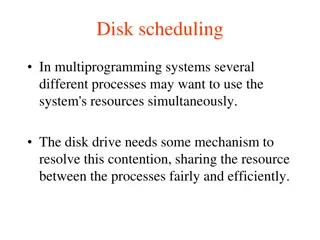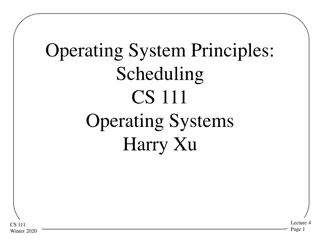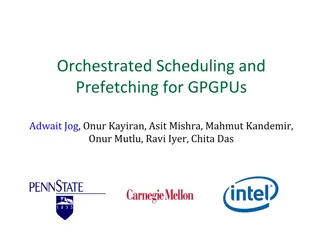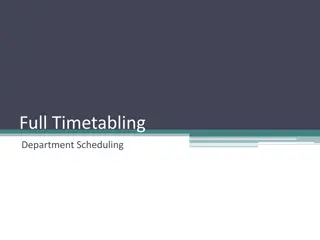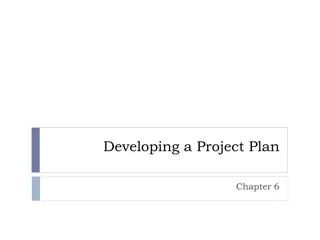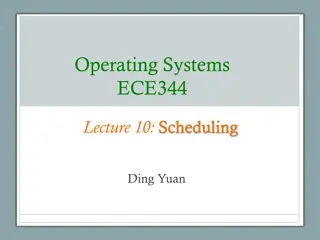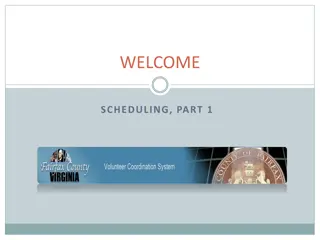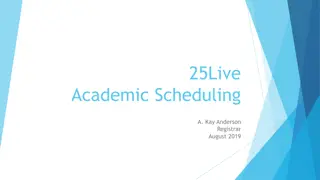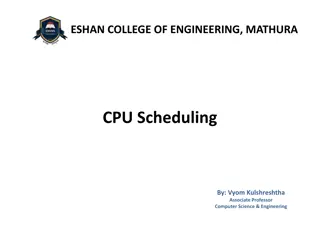Comprehensive Guide to Project Scheduling and Network Terminology
Understand the key concepts of project scheduling, network terminology, and IT networking with insights into critical paths, activities, and event sequencing. Discover the importance of establishing business networks and how project networks aid in planning, scheduling, and monitoring project progress efficiently.
Download Presentation

Please find below an Image/Link to download the presentation.
The content on the website is provided AS IS for your information and personal use only. It may not be sold, licensed, or shared on other websites without obtaining consent from the author.If you encounter any issues during the download, it is possible that the publisher has removed the file from their server.
You are allowed to download the files provided on this website for personal or commercial use, subject to the condition that they are used lawfully. All files are the property of their respective owners.
The content on the website is provided AS IS for your information and personal use only. It may not be sold, licensed, or shared on other websites without obtaining consent from the author.
E N D
Presentation Transcript
Project Project Scheduling Scheduling NETWORK, DURATION ESTIMATION, & CRITICAL PATH NETWORK, DURATION ESTIMATION, & CRITICAL PATH KULIAH 10 KULIAH 10 Magister Sistem Informasi Universitas Komputer Indonesia SOURCE: LARSON, E.W., GRAY C.F., 2011, 5TH ED.; PINTO, J.K. 2010, 2ND. ED.
PROJECT SCHEDULING Project Scheduling, represents the conversion of projects goals into an achievable methodology for their completion; it creates a timetable and reveals the network logic that relates the project activities to each other in a coherent fashion.
IT NETWORK In information technology, a network is a series of points or nodes interconnected by communication paths. Networks can interconnect with other networks and contain subnetworks.
Business NETWORK Business NETWORK Business networking is the process of establishing a mutually beneficial relationship with other business people and potential clients and/or customers.
Project NETWORK Project NETWORK Network is the tool used for planning, scheduling, and monitoring the project/activity progress. The network is developed from the information collected for WBS and is a graphic flow chart of the project job plan.
NETWORK TERMINOLOGY Activity, is an element of the project that requires time. It may or may not require resources. Merge activity, this is an activity that has more than one activity immediately preceeding it. Parallel activities, are activities that can take place at the same time. Path, a sequences of connected, dependent activities. Critical path, the paths with the longest duration through the network. Event, a point in time when an activity is started or completed. It does not consume time. Burst activity, this activity has more than one activity immediately following it (more than one dependency).
Network & Scheduling Scheduling define network logics for all activities ; that is, must either precede or follow other tasks from the beginning of the project to its completion.
Task Needed to Complete Assignment (Example) Identify topic Research topic Write first draft of paper Edit and rewrite paper Prepare class presentation Complete final draft Complete presentation Hand in paper and present topic in class
Network Diagram Serial Sequential Logic D A B C Edit Paper Identify topic Research Draft Paper G F H E Finish Final Draft Finish Prepare Presentation Presentation
Network Diagram Nonserial Sequential Logic A Identify topic D F Edit Paper Final Draft H C B Finish Draft Paper Research E G Prepare Presentation Finish Presentation
NETWORK APPROACHES Activity on Node (AON) Activity on Arrow (AOA) 2 A D 3 5 E B 7 F 3 1 3 5 4 4 1 C 1 1 12 Both methods use two building blocks the arrow and the node.
BASIC RULES IN DEVELOPING NETWORK Networks flow typically from left to right. An activity cannot begin untill all preceeding connected activities have been completed. Arrows indicate precedence and flow. Arrows can cross over each other. Each activity should have a unique identification number. An activity identification number must be larger than that of any activities that preecede it. Looping is not allowed. Conditional statements are not allowed.
ACTIVITY ON NODE An activity is represented by a node (box). The node can take many forms, but in recent years the node represented as a rectangle. The dependencies among activities are depicted by arrows. The arrows indicate how the activities are related and the sequence in which must be accomplished. Sometimes called the precedence diagram method.
Three Basic Relationship Which activities must be completed immediately before this activity? These activities are called predecessor activities. Which activities must immediately follow this activity? These activities are called successor activities. Which activities can occur while this activity is taking place? This is known as concurrent or parallel relationship.
Activity on Node Fundamentals A is preceded by nothing B is preceded by A C is preceded by B Y and Z is preceded by X Y and Z can begin at the same time X is a burst activity
Activity on Node Fundamentals J,K, &L can all begin at the same time, but all (J,K,L) must be completed before M can begin. M is a merge activity Q is preceeded by O and P R is preceeded by O and P
AON Project Network Example ID Description Preceding Activity A Contract Signing None B Questioner Design A C Target Market ID A D Survey Sample B,C E Develop presentation B F Analyse results D G Demographic Analysis C H Presentation to Client E,F,G
AON Network Example E B Develop Presentation Questioner D F A H Survey Sample Analyse Results Contract Signing Presentation C G Market ID Analyse Results
AON Project Duration Example ID Description Preceding Activity Estimated Duration A Contract Signing None 5 B Questioner Design A 5 C Target Market ID A 6 D Survey Sample B,C 13 E Develop presentation B 6 F Analyse results D 4 G Demographic Analysis C 9 H Presentation to Client E,F,G 2
AON Network Example E B Develop Presentati Question Design 6 5 D F H A Survey Sample Analyse Result Present to Client Contract 5 13 4 2 C G Legend Target Market ID Demog. Analysis ES ID EF Description SL 6 9 LS Dur LF
Fordward Pass Earliest Time 10 E 16 5 B 10 Develop Presentati Question Design 6 5 24 11 D 24 F 28 28 H 30 0 A 5 Survey Sample Analyse Result Present to Client Contract 5 13 4 2 5 C 11 11 G 20 Legend Target Market ID Demog. Analysis ES ID EF Description SL 6 9 LS Dur LF
Backward Pass Latest Time 10 E 16 5 B 10 Develop Presentati Question Design 6 5 24 11 D 24 F 28 28 H 30 0 A 5 Survey Sample Analyse Result Present to Client Contract 5 13 4 2 5 C 11 11 G 20 Legend Target Market ID Demog. Analysis ES ID EF Description SL 6 9 LS Dur LF
SLACK (or FLOAT) Total slack (TS), tells us the amount of time an activity can be delayed and not delay the project. Free slack (FS), it is the amount of time an activity can be delayed without delaying any immediately following (successor) activity.
FREE SLACK EXAMPLE 2 B 7 0 Install drainage 0 A 2 7 D 11 11 E 14 2 5 7 TS=0 FS=0 0 Survey site 0 Excavate site 0 Pour foundation 2 C 5 0 2 2 7 4 11 11 3 14 2 Install power line TS=0 FS=0 TS=0 FS=0 4 3 7 Legend ES ID EF TS=2 FS=2 Description SL LS Dur LF
STEP TO REDUCE THE CRITICAL PATH Eliminate task on the critical path Replan serial paths to be in parallel Overlap sequential tasks Shorten the duration of critical path tasks Shorten early task Shorten longest task Shorten easiest task Shorten tasks that cost the least to speed up
Creating an activity network Assume the following information: Activity Predecessor A - B A C B D B E C,D F C G E,F H D,G Create an activity network that shows the sequential logic between project task. Can you identify merge activities? Burst activities?
Calculating Activity Duration Assume that you have the following estimates. Using the beta distribution, estimate the activity duration for each task. Duration Estimates Activity Pessimistic Likely Optimistic A 7 5 2 B 5 3 2 C 14 8 6 D 20 10 6 E 8 3 3 F 10 5 3 G 12 6 4 H 16 6 5
Determining Critical Path and Activity Slack J. Wold, project manager of Print Software, Inc. Wants you to prepare a project network; compute the early, late, and slack activity times; determine the planned project duration; and identify the critical path. His assistant has collected the following information for the Color Printer Drivers Software Project.
EXERCISE (Continued) ID Description Predecessor Time A External specifications None 8 B Review design features A 2 C Document new features A 3 D Write software A 60 E Program and test B 60 F Edit and publish notes C 2 G Review manual D 2 H Alpha site E,F 20 I Print manual G 10 J Beta site H,I 10 K Manufacture J 12 L Release and ship K 3
Greendale Stadium Case The G&E Company is preparing a bid to build the new 47,000 seat baseball stadium. The construction must start July 1, 2013, and be completed in time for the start of the 2016 season. A penalty clause $100,000 per day of delay beyond May 20, 2016, is written into the contract. Ben Keith, the president of the company, expressed optimism of obtaining the contract and revealed that company could net as much as $2 million on the project. He also said if they are successful, the prospects for future projects are quite good since there is projected a renaissance in building classic ball parks with modern luxury boxes. Assignment: Given the information provided in the next table, construct a network schedule for the stadium project and answer the following questions: 1. Will the project be able to be completed by the May deadline? How long will it take? 2. What is the critical path for the project? 3. Based on the schedule would you recommend that G&E pursue this contract? Why? Include a one-page Gant chart for the stadium schedule.
ID Activity Duration (days) Predecessor(s) 1 Baseball Stadium 2 Clear stadium site 70 - 3 Demolish building 30 2 4 Set up construction site 70 3 5 Drive support piling 120 2 6 Pour lower concrete bowl 120 5 7 Pour main concourse 120 3,6 8 Install Playing Field 90 3,6 9 Construct upper steel bowl 120 3,6 10 Install seats 140 7,9 11 Build luxury boxes 90 7,9 12 Install jumbotron 30 7,9 13 Stadium infrastructure 120 7,9 14 Construct steel canopy 75 10 15 Light installation 30 14 16 Build roof supports 90 6 17 Construct roof 180 16 18 Install roof tracks 90 16 19 Install roof 90 17,18 20 Inspection 20 8,11,13,15,19
